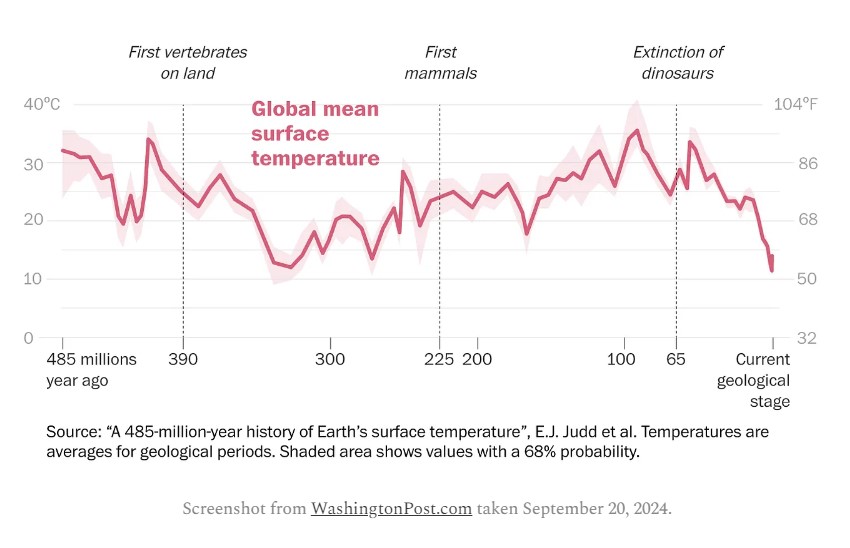Marc Morano
Climate Depot
Dec 9, 2010
http://www.prisonplanet.com/special-report-more-than-1000-international-scientists-dissent-over-man-made-global-warming-claims-challenge-un-ipcc-gore.html
Link to Complete 321-Page PDF Special Report
INTRODUCTION:
More than 1000 dissenting scientists (updates previous 700 scientist report) from around the globe have now challenged man-made global warming claims made by the United Nations Intergovernmental Panel on Climate Change (IPCC) and former Vice President Al Gore. This new 2010 320–page Climate Depot Special Report — updated from 2007′s groundbreaking U.S. Senate Report of over 400 scientists who voiced skepticism about the so-called global warming “consensus” — features the skeptical voices of over 1000 international scientists, including many current and former UN IPCC scientists, who have now turned against the UN IPCC. This updated 2010 report includes a dramatic increase of over 300 additional (and growing) scientists and climate researchers since the last update in March 2009. This report’s release coincides with the 2010 UN global warming summit being held in Cancun.
The more than 300 additional scientists added to this report since March 2009 (21 months ago), represents an average of nearly four skeptical scientists a week speaking out publicly. The well over 1000 dissenting scientists are almost 20 times the number of UN scientists (52) who authored the media-hyped IPCC 2007 Summary for Policymakers.
The chorus of skeptical scientific voices grew louder in 2010 as the Climategate scandal — which involved the upper echelon of UN IPCC scientists — detonated upon on the international climate movement. “I view Climategate as science fraud, pure and simple,” said noted Princeton Physicist Dr. Robert Austin shortly after the scandal broke. Climategate prompted UN IPCC scientists to turn on each other. UN IPCC scientist Eduardo Zorita publicly declared that his Climategate colleagues Michael Mann and Phil Jones “should be barred from the IPCC process…They are not credible anymore.” Zorita also noted how insular the IPCC science had become. “By writing these lines I will just probably achieve that a few of my future studies will, again, not see the light of publication,” Zorita wrote. A UN lead author Richard Tol lead author grew disillusioned with the IPCC and lamented that it had been “captured” and demanded that “the Chair of IPCC and the Chairs of the IPCC Working Groups should be removed.” Tol also publicly called for the “suspension” of IPCC Process in 2010 after being invited by the UN to participate as lead author again in the next IPCC Report.
Other UN scientists were more blunt. South African UN scientist declared the UN IPCC a “worthless carcass” and noted IPCC chair Pachauri is in “disgrace”. He also explained that the “fraudulent science continues to be exposed.” Alexander, a former member of the UN Scientific and Technical Committee on Natural Disasters harshly critiqued the UN. “‘I was subjected to vilification tactics at the time. I persisted. Now, at long last, my persistence has been rewarded…There is no believable evidence to support [the IPCC] claims. I rest my case!” See: S. African UN Scientist Calls it! ‘Climate change – RIP: Cause of Death: No scientifically believable evidence…Deliberate manipulation to suit political objectives’ [Also see: New Report: UN Scientists Speak Out On Global Warming — As Skeptics!] Geologist Dr. Don Easterbrook, a professor of geology at Western Washington University, summed up the scandal on December 3, 2010: “The corruption within the IPCC revealed by the Climategate scandal, the doctoring of data and the refusal to admit mistakes have so severely tainted the IPCC that it is no longer a credible agency.”
Selected Highlights of the Updated 2010 Report featuring over 1000 international scientists dissenting from man-made climate fears:
“We’re not scientifically there yet. Despite what you may have heard in the media, there is nothing like a consensus of scientific opinion that this is a problem. Because there is natural variability in the weather, you cannot statistically know for another 150 years.” — UN IPCC’s Tom Tripp, a member of the UN IPCC since 2004 and listed as one of the lead authors and serves as the Director of Technical Services & Development for U.S. Magnesium.
“Any reasonable scientific analysis must conclude the basic theory wrong!!” — NASA Scientist Dr. Leonard Weinstein who worked 35 years at the NASA Langley Research Center and finished his career there as a Senior Research Scientist. Weinstein, is presently a Senior Research Fellow at the National Institute of Aerospace.
“Please remain calm: The Earth will heal itself — Climate is beyond our power to control…Earth doesn’t care about governments or their legislation. You can’t find much actual global warming in present-day weather observations. Climate change is a matter of geologic time, something that the earth routinely does on its own without asking anyone’s permission or explaining itself.” — Nobel Prize-Winning Stanford University Physicist Dr. Robert B. Laughlin, who won the Nobel Prize for physics in 1998, and was formerly a research scientist at Lawrence Livermore National Laboratory.
“In essence, the jig is up. The whole thing is a fraud. And even the fraudsters that fudged data are admitting to temperature history that they used to say didn’t happen…Perhaps what has doomed the Climategate fraudsters the most was their brazenness in fudging the data” — Dr. Christopher J. Kobus, Associate Professor of Mechanical Engineering at Oakland University, specializes in alternative energy, thermal transport phenomena, two-phase flow and fluid and thermal energy systems.
“The energy mankind generates is so small compared to that overall energy budget that it simply cannot affect the climate…The planet’s climate is doing its own thing, but we cannot pinpoint significant trends in changes to it because it dates back millions of years while the study of it began only recently. We are children of the Sun; we simply lack data to draw the proper conclusions.” — Russian Scientist Dr. Anatoly Levitin, the head of geomagnetic variations laboratory at the Institute of Terrestrial Magnetism, Ionosphere and Radiowave Propagation of the Russian Academy of Sciences.
“Hundreds of billion dollars have been wasted with the attempt of imposing a Anthropogenic Global Warming (AGW) theory that is not supported by physical world evidences…AGW has been forcefully imposed by means of a barrage of scare stories and indoctrination that begins in the elementary school textbooks.” — Brazilian Geologist Geraldo Luís Lino, who authored the 2009 book “The Global Warming Fraud: How a Natural Phenomenon Was Converted into a False World Emergency.”
“I am an environmentalist,” but “I must disagree with Mr. Gore” — Chemistry Professor Dr. Mary Mumper, the chair of the Chemistry Department at Frostburg State University in Maryland, during her presentation titled “Anthropogenic Carbon Dioxide and Global Warming, the Skeptic’s View.”
“I am ashamed of what climate science has become today,” The science “community is relying on an inadequate model to blame CO2 and innocent citizens for global warming in order to generate funding and to gain attention. If this is what ‘science’ has become today, I, as a scientist, am ashamed…Science is too important for our society to be misused in the way it has been done within the Climate Science Community.” Swedish Climatologist Dr. Hans Jelbring,
“Those who call themselves ‘Green planet advocates’ should be arguing for a CO2- fertilized atmosphere, not a CO2-starved atmosphere…Diversity increases when the planet was warm AND had high CO2 atmospheric content…Al Gore’s personal behavior supports a green planet – his enormous energy use with his 4 homes and his bizjet, does indeed help make the planet greener. Kudos, Al for doing your part to save the planet.” — Renowned engineer and aviation/space pioneer Burt Rutan, who was named “100 most influential people in the world, 2004″ by Time Magazine and Newsweek called him “the man responsible for more innovations in modern aviation than any living engineer.”
“Global warming is the central tenet of this new belief system in much the same way that the Resurrection is the central tenet of Christianity. Al Gore has taken a role corresponding to that of St Paul in proselytizing the new faith…My skepticism about AGW arises from the fact that as a physicist who has worked in closely related areas, I know how poor the underlying science is. In effect the scientific method has been abandoned in this field.” — Atmospheric Physicist Dr. John Reid, who worked with Australia’s CSIRO’s (Commonwealth Scientific and Industrial Research Organization) Division of Oceanography and worked in surface gravity waves (ocean waves) research.
“We maintain there is no reason whatsoever to worry about man-made climate change, because there is no evidence whatsoever that such a thing is happening.” — Greek Earth scientists Antonis Christofides and Nikos Mamassis of the National Technical University of Athens’ Department of Water Resources and Environmental Engineering.
“There are clear cycles during which both temperature and salinity rise and fall. These cycles are related to solar activity…In my opinion and that of our institute, the problems connected to the current stage of warming are being exaggerated. What we are dealing with is not a global warming of the atmosphere or of the oceans.” — Biologist Pavel Makarevich of the Biological Institute of the Russian Academy of Sciences
“Because the greenhouse effect is temporary rather than permanent, predictions of significant global warming in the 21st century by IPCC are not supported by the data.” — Hebrew University Professor Dr. Michael Beenstock an honorary fellow with Institute for Economic Affairs who published a study challenging man-made global warming claims titled “Polynomial Cointegration Tests of the Anthropogenic Theory of Global Warming.”
“The whole idea of anthropogenic global warming is completely unfounded. There appears to have been money gained by Michael Mann, Al Gore and UN IPCC’s Rajendra Pachauri as a consequence of this deception, so it’s fraud.” — South African astrophysicist Hilton Ratcliffe, a member of the Astronomical Society of Southern Africa (ASSA) and the Astronomical Society of the Pacific and a Fellow of the British Institute of Physics.
End Selected Excerpts




